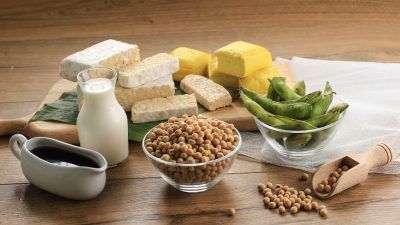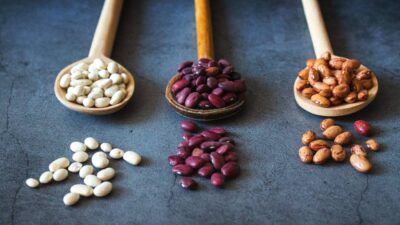Soya

Is it a wonder bean or is it dangerous? There are probably more myths, misinformation and downright lies about soya than any other food. The scare stories about the detrimental health effects of this humble bean are simply not supported by scientific research, but still, they persist. Here, we set the record straight once and for all!
A little bit of history
There is a long history of people consuming soya that dates back to the 11th century BC in China. The period from the first to the 16th century AD saw the introduction of soya into many parts of Asia, including Japan and India and in the 18th century, it reached Europe and the USA. Since then, it has become gradually more and more popular and its cultivation flourished, with many European countries now producing large quantities.
Nutritional value
Soya is a particularly good source of protein as it contains all the essential amino acids (protein building blocks) which the human body needs and is higher in protein than other pulses. It also supplies essential polyunsaturated fats (omega-3 and -6), fibre and is an excellent source of disease-busting antioxidants, B vitamins and iron. Calcium-fortified soya products such as soya milk and yoghurt, and calcium-set tofu, provide substantial amounts of this important mineral.
Traditional versus modern
Most of the traditional soya products such as tofu, tempeh, soya milk, soya sauce and miso, use the whole bean and so contain more nutrients than foods based on soya protein isolate alone. The latter is a protein extract from soya beans which can be labelled as textured vegetable protein (TVP) and is used in various mock meats and other processed foods. It follows that tofu is healthier than a TVP sausage.
Highly processed foods tend to contain too much fat, salt/sugar and artificial additives, which have all been linked to health problems. However, many mock meat products do provide a valuable low-fat (check the packaging for details) and cholesterol-free source of good protein. This makes them a better option than their meaty or milky equivalents, which contain saturated fat, animal protein, cholesterol and hormones. There’s a simple rule – eat wholefoods daily but have processed mock meats no more than three times a week.
Phytoestrogens
Phytoestrogens are natural substances found in many fruits, vegetables, beans, peas and wholegrains. Their chemical structure is similar, but not identical, to human oestrogen. Isoflavones are a type of phytoestrogen found in soya beans and, depending on the type, isoflavones are estimated to be between 100 and 100,000 times weaker than actual oestrogens.
In women experiencing extreme highs and lows of their oestrogen levels, as during puberty and menopause, phytoestrogens can have a normalising effect on hormone levels. If a woman has high oestrogen levels, phytoestrogens may ever-so-slightly reduce them by binding to oestrogen receptors and, to some degree, blocking access to the stronger oestrogens. When oestrogen levels are very low, the weak effect of phytoestrogens can slightly increase those levels and so relieve menopausal symptoms.
There were concerns that phytoestrogens might affect sexual development and fertility but those were based on animal experiments. Human studies, on the other hand, show that soya phytoestrogens are not only safe to consume but also health-protective.
Health benefits
Regular soya consumption has many benefits and probably the best established one is that it reduces cholesterol levels and lowers your risk of heart disease. Even in people who already have atherosclerosis (hardening and narrowing of the arteries), it may help improve their blood vessel health.
A wealth of studies shows that regular soya intake can reduce your risk of developing cancer, in particular breast, prostate and bowel cancer. Research indicates it may reduce the risk of endometrial and stomach cancer as well. In women who’ve had breast cancer, soya consumption reduces the risk of the cancer recurring.
Soya is also an invaluable friend to menopausal women because it can reduce both frequency and severity of hot flushes. On top of that, it can be very helpful in preventing bone loss in menopausal and postmenopausal women who are at risk of osteoporosis. It’s worth making it a staple on your menu – soya milk, tofu or soya yoghurt, they all count – and aim for two to three servings daily for best effect. That, however, can get a little challenging so you may want to add an isoflavone supplement to your diet – not to replace soya food but to top up your intake.
There are also some studies suggesting that soya or soya isoflavones can improve your cognitive skills but more research is needed.
The thyroid
Concerns have been raised about the effect of soya on the thyroid but many studies show that if you’re healthy and have sufficient iodine intake, you can eat soya without giving it a second thought. In people with hypothyroidism (reduced thyroid function), there’s a small risk that soya may interfere with the daily hormones people take. In that case, it’s best to take the hormones and then wait a few hours before eating soya foods.
Soya formula
Even though breastfeeding is best for babies, it’s not always possible and parents have to find a suitable alternative – an infant formula. Recent reviews of soya-based infant formulas found that they are perfectly safe, ensure normal growth and development, produce healthy bones and immune system and have no adverse effects whatsoever on baby’s reproductive and endocrine (hormone) functions.
Soya sustainability
Some people believe soya is bad for the environment because it’s grown on deforested land in the Amazon and elsewhere in the region. They’re right to be concerned but vegans are not the problem – close to 80 per cent of the world’s soya production is fed to livestock so that people can eat meat, eggs and dairy. Both the rainforests and our health would benefit greatly if more people ate soya instead of animal products. Most of the soya for human consumption in Europe is also grown in Europe, sustainably and without genetic modification – and what’s more, soya cultivation enriches the soil!
If you ever hear someone badmouthing soya, they either have outdated information or have fallen victim to scaremongering stories. This mighty little bean has a lot to offer and it’s undoubtedly good for you!







